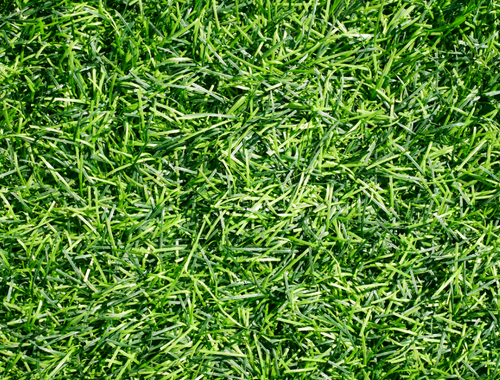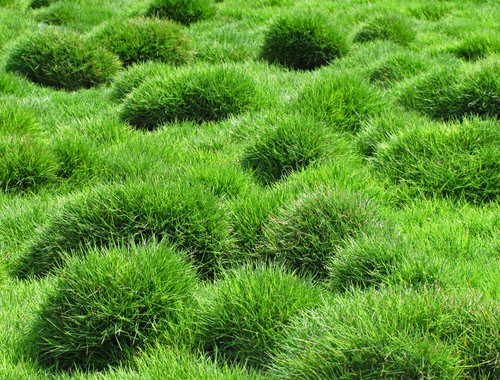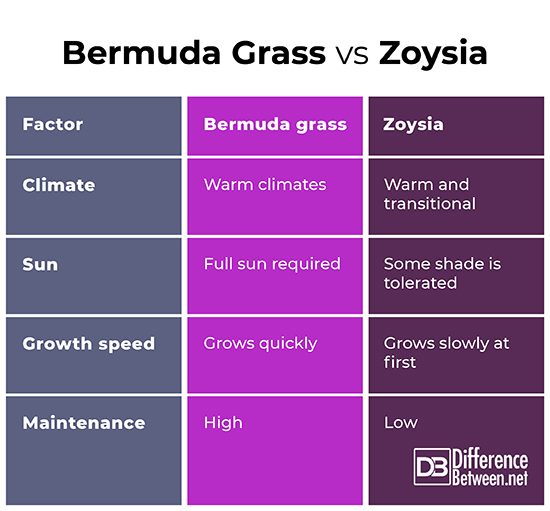Difference Between Bermuda Grass and Zoysia

Bermuda Grass
Bermuda grass (Cynodon dactylon) is a warm temperature grass that is found in tropical and subtropical regions across the world. It is native to the Mediterranean region. It was already found in the United States as early as 1807 in the southern states. Although it is not actually native to Bermuda, it is considered an invasive species on the island. Bermuda grass is adapted to warm climates with regular droughts. It can easily tolerate hot climates and dry conditions. For this reason, it is used as lawn grass by homeowners and for sports fields and golf courses in southern parts of the United States including the southern states, the American southwest, and California.
In climates where there is no frost, Bermuda grass is green year-round. In climates with frost, Bermuda grass will go dormant during winter and other times when frost is prevalent. During its dormancy, the grass will remain a brown color. Bermuda grass is known for being fast growing. The grass will typically grow to 4-16 inches in height. The roots of Bermuda grass will usually grow down to no more than six inches beneath the surface, but it is possible for them to grow as far down as six feet. This extensive root system helps make Bermuda grass more resilient to environmental stressors compared to other warm season grasses.
What are the advantages of Bermuda grass?
Bermuda grass is fast growing and drought resistant. It is suitable for warm climates with dry periods, such as southern California. Fields of Bermuda grass can also endure heavy foot traffic. For this reason, Bermuda grass is often used on sports fields and golf courses in warm-climate areas.
What are the drawbacks of Bermuda grass?
In colder areas where frost is prevalent, Bermuda grass will go brown during the winter and will generally stay brown longer than other warm-adapted grasses. Bermuda grass is also relatively high maintenances and requires a high amount of nutrients compared to other grasses. Because it is fast-growing, Bermuda grass can also easily become an invasive species, as can be seen in the case of the island of Bermuda.

Zoysia
Zoysia is a warm temperature grass that is native to Asia and was introduced to the United States around 1895. Zoysia starts out slow growing, but it is a very aggressive plant which can choke out weeds and form a dense turf that very few other plants can penetrate. Zoysia is used as a lawn grass both in warm regions of the United States, such as the southern states, and the so-called “transition zone” between the colder areas where northern grasses flourish and the warmer areas where the sun and heat-loving southern grasses predominate. Zoysia is more cold-tolerant than other warm climate adapted grasses. It also fairs better in the transition zone than northern cold-adapted grasses because of its heat tolerance. As a result, it can be used in a larger variety of climates than certain other grasses. In colder climates, zoysia will turn brown and go dormant during winter. Nonetheless, Zoysia stays green longer than other warm season grasses in the colder months. Zoysia is also a relatively low maintenance and low water-requiring grass. One of the drawbacks of zoysia is that, since it is so aggressive, it can easily become an invasive species, causing problems when it starts to grow in areas where it is not wanted.
Similarities between Bermuda grass and zoysia
Bermuda grass and zoysia grass are both warm-temperature grasses. They are also both known for forming a resilient turf. They are both ideal as grasses for athletic fields and golf-courses where there is heavy foot traffic. Furthermore, they both can become invasive species because they grow aggressively.
Differences between Bermuda grass and zoysia
How can you tell the difference between zoysia and Bermuda grass?
Although there are similarities between Bermuda grass and zoysia grass, there are also important differences. These differences include the following.
- Bermuda grass is primarily a warm climate grass, whereas zoysia grass can grow easily in warm climates and transition zone climates.
- Bermuda grass is known for growing fast, whereas zoysia grass starts out growing slowly.
- Bermuda grass requires full sun, whereas zoysia grass can tolerate limited shade.
- Bermuda grass is considered a high maintenance grass, whereas zoysia is considered low maintenance.
Is Bermuda grass or zoysia better?
Bermuda grass is faster growing. Zoysia is better for colder areas where the grower of the grass wants the green color to return earlier in the spring and stay longer in the fall. Which one is better depends on the climate, how quickly a lawn needs to be established, and how long it needs to stay green. Zoysia grass will stay green longer and endure in a larger variety of climates. Bermuda grass, on the other hand, will grow faster and be established more quickly.
Can I mix zoysia and Bermuda grass?
Since they are both warm temperature grasses, it may be possible to mix them depending on the climate. They are both aggressive grasses, however, and may not allow each other to grow in the same place.
Does zoysia overtake Bermuda grass?
Bermuda grass is faster growing than zoysia grass initially, so Bermuda grass would likely have a head start if they were both planted at the same time. On the other hand, in a colder climate where frost is prevalent, zoysia would continue to grow and remain green for longer than Bermuda grass. Thus, zoysia could overtake Bermuda grass in a cold climate during the fall since Bermuda grass would go dormant first and during the spring since zoysia would come out of dormancy before Bermuda grass. On the other hand, Bermuda grass would be more likely to overtake zoysia at the beginning of the growing season if they were planted at the same time since Bermuda grass grows faster. This is of course assuming that the zoysia turf had not already been established.
Bermuda grass vs zoysia

Summary
Bermuda grass is a warm temperature grass used in climates with high heat and regular droughts. It has low tolerance for cold temperatures and does not do well in transitional regions. During the winter in cold areas which have frost, it will go brown. It grows quickly and can form a thick turf. It is ideal for use in sports fields and golf courses in warm climate areas. Zoysia is a grass that grows well in transition regions and warm climate regions. It is known for forming a resilient turf and being able to withstand heavy foot traffic. It is also more tolerant of cold than other warm-temperature grasses. Bermuda grass and zoysia grass are similar in that they both are known for forming thick, resilient turfs, go brown in cold months in cooler climates, and are well adapted to warm regions. They differ in that Bermuda grass has difficulty in cold climates, requires full exposure to the sun, is known for growing quickly, and is considered relatively high maintenance compared to other grasses. Zoysia, on the other hand, can grow easily in warm or transitional climates, can tolerate some shade, grows more slowly initially, and is considered relatively low maintenance compared to other grasses.
- Difference Between Environmental Performance Index and Development - November 24, 2023
- Difference Between Environmental Intervention and Development - November 8, 2023
- Difference Between Eco Efficiency and Eco Effectiveness - September 18, 2023
Search DifferenceBetween.net :
Leave a Response
References :
[0]“All you need to know about Bermuda grass.” Pennington.com, n.d., https://www.pennington.com/all-products/grass-seed/resources/all-you-need-to-know-about-bermudagrass.
[1]“All you need to know about zoysia grass.” Pennington.com, n.d., https://www.pennington.com/all-products/grass-seed/resources/all-you-need-to-know-about-zoysia-grass.
[2]Britannica, The Editors of Encyclopaedia. "Bermuda grass". Encyclopedia Britannica, 29 Jan. 2016, https://www.britannica.com/plant/Bermuda-grass. Accessed 18 November 2022.
[3]“How to choose the right grass seed for your region.” Pennington.com, n.d., https://www.pennington.com/all-products/grass-seed/resources/recommended-grasses-for-regional-climates#TransitionRegion.
[4]“Zoysiagrass.” Clemson University Home & Garden Information Center, 15 November 2018, https://hgic.clemson.edu/factsheet/zoysiagrass/.
[5]Uncle. “Zoysia Grass – The Good, The Bad, and the Ugly.” Pennington.com, https://grasspad.com/zoysia-grass-the-good-the-bad-and-the-ugly/. Accessed 18 November 2022.
